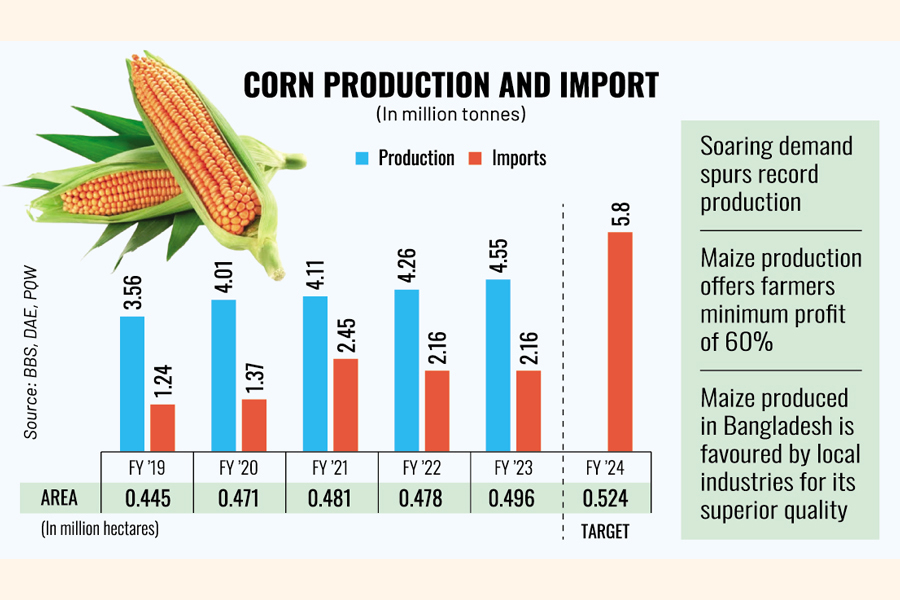
Published :
Updated :

Rocketing demand for maize from the feed and food-processing industries is driving the continued expansion of the cereal crop's farming across the country, with production reaching an all-time high in the last financial year.
Maize production reached a record 4.55 million tonnes in the last FY, cultivated on over 0.5 million hectares of land across both winter and summer seasons, according to the Bangladesh Bureau of Statistics (BBS).
However, this local production is proving insufficient, with traders also importing large volumes of maize annually to meet demand.
The Department of Agricultural Extension (DAE) is ambitious for the current season, setting a target to harvest a record-breaking 5.81 million tonnes of maize from 0.543 million hectares.
"For the ongoing Rabi [winter] season, our target was to cultivate maize on 0.524 million hectares, but farmers have exceeded expectations by planting on 0.543 million hectares," said Dr Tajul Islam Patwary, Director of the DAE Field Service Wing.
He said the climate is so well-suited to maize that they expect production to even surpass 5.8 million tonnes. Harvesting has already begun (around 4 per cent complete) and will continue until June.
Dr Golam Faruq, director general of the Bangladesh Wheat and Maize Research Institute, pointed to the high prices for maize amid surging demand from the feed industry, currently exceeding Tk 34 per kg.
"Maize production offers farmers a minimum profit margin of 60 per cent, which has incentivised many to switch from crops like potato, vegetables and even rice to maize cultivation in the northern, northwestern, southwestern and central regions of the country over the past five years," said Dr Faruq.
The Feed Industries Association of Bangladesh President Shamsul Arefin Khaled elaborated on maize use, saying that 50-60 per cent of the local agri output is used in poultry feed, with another 12 per cent going to animal feed.
"Beyond the feed industry, the confectionery, hotel and restaurant sectors are also significant consumers of maize," he added.
Maize produced in Bangladesh is favoured by local industries for its superior quality, according to Mr Khaled, encouraging efforts to source as much maize as possible from domestic markets.
Maize silage -- a fermented livestock feed replacing traditional grass -- has grown in popularity.
Mr Khaled said silage can reduce grain feed requirements by up to 30 per cent. Besides, 10-15 per cent of maize is allocated for the fish feed industry.
He said while domestic maize production has increased fivefold in the past fifteen years, demand has grown even faster.
To meet the rising demand of 6.0-6.5 million tonnes, private companies also require imported maize. According to the Plant Quarantine Wing, private importers brought in 2.0 to 2.4 million tonnes of maize over the last five years.
Farm economist Professor Golam Hafiz Kennedy traced the origins of maize cultivation in Bangladesh to the 1990s, following the expansion of the poultry industry.
He highlighted how the production of maize, jute, meat and milk has enormously contributed to improving living standards for local farmers.
Maize cultivation, in particular, has emerged as a pivotal factor in alleviating poverty among farmers in the northern and southwestern regions, said Professor Kennedy.
He provided an example: farmers in Nilphamari can earn Tk 40,000 to Tk 42,000 from selling maize grown on 33 decimals of land, with a maximum investment of Tk 16,000.
Such profits are difficult with other crops.
However, Professor Kennedy cautioned that a drop in demand from the feed industry can sometimes bring hardship to farmers.
Sadid Jamil, managing director of Metal, an agro-machinery company, said the availability of modern equipment for land preparation, harvesting and shelling has further encouraged farmers to cultivate maize.
Farmers now harvest maize using combine harvesters and then extract kernels from the cobs using modern maize shellers, said the Metal MD.
He added that maize shellers have reduced threshing costs by 80 per cent in most regions.
tonmoy.wardad@gmail.com


 For all latest news, follow The Financial Express Google News channel.
For all latest news, follow The Financial Express Google News channel.